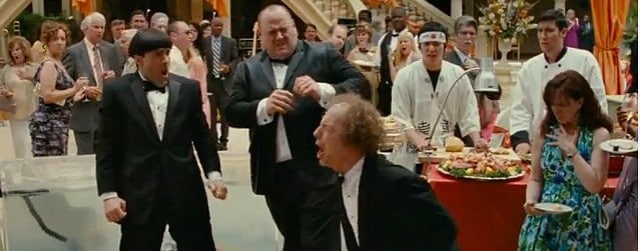Interview: Peter Farrelly Talks Finding ‘The Three Stooges’ in Modern America and How Wes Anderson Helped Save ‘There’s Something About Mary’

The Three Stooges has been a passion project for the Farrelly brothers for almost a decade. From swapping studios to switching up actors, the project has gone through plenty of ups and downs, and it seemed as though it would never make it to the screen. After a few revisions and dedication, Bob and Peter Farrelly’s modern day take on The Three Stooges finally got off the ground.
According to Peter Farrelly, only the film’s environment is “modern.” Instead of going with satire or irony, the Farrelly’s wanted to stick with and respect the old-fashioned physical comedy the Stooges are famous for. Yes, there is a Jersey Shore gag (something I’m guessing wasn’t in the original Stooges’ work), but the Farrelly’s set out to recreate the spirit and charm of The Three Stooges.
Here’s what Peter Farrelly had to say about receiving the PG rating, writing oblivious but lovable characters, bringing the Stooges back to life, and how Wes Anderson inadvertently helped save There’s Something About Mary:
Obviously the script took a while to crack. At what point did you get the structure and know the tone you wanted?
Tonally, it changed a little over the years, but mainly it was the same. From the time we wanted to make the Stooges, we didn’t want to throw our sensibilities on the Stooges; we wanted to adjust to theirs. Tonally, it is like a PG movie. Even though there is a lot of hitting, there’s no blood, guts, no nudity, or language. It wasn’t hard to find the tone, but it was hard to get it right; it took a lot of doing. Luckily, we had many years to work on it.
Were you pretty surprised by how much violence you can have with no blood?
Yeah, I was surprised. Before we shot it, we actually gave the script to the MPAA and said, “What will this be rated?” I didn’t know if they were going to say R, PG-13, or PG. It was a PG, because it is cartoony violence and there’s no repercussions. Ultimately they tell you under the table what to change. We just asked what it would be, and they said PG.
Did you and Bob always want the PG?
We didn’t know what it would be, but we had to know because we were pitching it to the studios and I wanted them to know what they would be getting. If it wasn’t going to be PG… it’s a lot easier to set it up with a PG, I’ll say that. It is for kids, and if you get younger kids in, then it’s all the better. We didn’t want to make a PG movie just to make a PG movie; we wanted it to be what it would naturally be, and if that was PG-13, I was fine with that.
You think that’s what it’d be now: an “edgy” PG-13 Stooges spoof.
Yeah, you could do that. Our first goal was to please the hard core Stooges’ fans, because we are those guys. I knew there were a lot of people out there saying, “I don’t know about this. This is a bad idea. How are you going to pull it off? How are you going to put it in the present day?” We wanted to show those guys it was doable. The reason we wanted to do it is because a lot of kids today don’t know the Stooges, and we just thought it was horrible the funniest guys in our lifetime were just fading away.
Which is odd. Physical comedy is timeless.
Exactly. You know, physical comedy ages the best. If you look at Preston Sturges from the 40s, his movies were a lot of verbal repartee. At the time, they were the height of sophistication, but they don’t hold up because that type of stuff changes. The physical stuff ‐ W. C. Fields, Charlie Chaplin, and Three Stooges ‐ you’ll still laugh at it.
Was there a challenge or question of blending a modern day sensibility with that humor, though? The Jersey Shore joke, for example.
Well, we knew we wanted to do it present day, but we also wanted them to look, dress, and sound the same way. It was a balancing act where we didn’t want them saying, “My bad!” On the other hand, we wanted them to be The Three Stooges, but we wanted them to be able to participate in a modern world, because we thought it would be more fun for the audience to see them in that context. Also, because we’re writing all this stuff, it allowed us to open it up a little bit by putting it in the present day.
I’d say you and Bob have tackled a lot of characters similar to the Stooges, people who are oblivious and yet lovable. Where’s that line where obliviousness could lean towards meanness?
That’s interesting. When we start a movie, a lot of people think we sit around and think of gags ‐ but we don’t, and that comes later. The first thing we do is try to develop characters who are so likable that we can hang our gags on them and you’ll put up with it, and that’s the trick. Even with Dumb and Dumber, there’s that scene before they go to Aspen where Jim [Carrey] says he doesn’t have anyone or anything, and he plays it straight, which makes you like him. It better make you like him, because two minutes later he’s selling a dead bird to a blind kid in a wheelchair. So it’s important to us that you like our characters. You know, with Dumb and Dumber, those characters love each other, which makes you love them. They care about each other, and it’s the same thing with The Three Stooges. Despite all the hitting and yelling, you know they have affection for each other.
There’s usually that dichotomy to what you guys do, where you can have a gag like the dead bird but you also go for a heart. Is that tone something you set out for or is it an unconscious style?
You know, it’s a combination, actually. In that case, it’s unconscious. We want it to be palatable and we wanted you to like the guys. It is important for all our movies for you to like our guys. If you don’t like them, then we’re in trouble.
What about a more malicious character, like Roy from Kingpin?
Yeah, the reason he gets away with it is because you can see why he is an asshole: he started as a nice guy who was cut down at the prime of his career, so he’s bitter. It’s that guy trying to find that innocence again. You root for him because he could have been.
Is that a constant discussion you have with actors on the set, as well?
I don’t think so. By the time we’re on set we have a script that we’ve looked at so much… actually, this is what happens: when we get on set we think the script is 100% there, but it isn’t. As we shoot it we’re going to find out it’s 80% there and that a lot of stuff isn’t going to work as you’re filming it, and you have to find that stuff. As far as the heart: that’s not the stuff we have to worry about at that point, because that’s been built in.
I’ve heard you say in a few interviews that the third story of the Stooges was always the most difficult. What was the problem and how was it solved?
You know, I’m trying to think when that would’ve been. Actually, yes, that’s exactly right. When we did Hall Pass we had a script for The Three Stooges that was a few years old, and we had just gone through it, and we realized the first two acts were as solid as a rock but the third act didn’t go where wanted it to go; it was too long, meandering, wasn’t satisfying, and didn’t make a lot of sense. We did a complete rewrite, but it kind of lost itself. That’s what writing is: fixing things up.
Can you recall a previous film where the writing process was all about that?
Pretty much every one of them, at one point or another, you hit walls. I remember, on There’s Something About Mary, when we were on around page 50, I couldn’t go on with writing it. It was so obvious that Mary was going to end up with Ted, and it was just a plain answer. Right around that time I watched Bottle Rocket. Have you seen that movie?
Yeah, it’s great.
I love that movie. The thing I loved about it was it started out with a guy getting out of a nut house and this five-year plan of robbing mom and pop stores. They have it all worked out. When they head out on the first day, they stop at a motel and the guy falls in love with the maid and they go off on a whole different tangent; they let the movie go where it wanted to go. I realized we were unconsciously forcing Ted and Mary together. I realized you had to write it as if anything could happen. From that point forward, we were more fair to the other characters: Woogie, Brett, and Pat. As we were writing it, we hadn’t made up our minds who she was going to end up with. By the end, we realized people think she’s going to end up with Brett Favre, so that allowed us to give her back to Ted.
I still don’t get why she didn’t pick Pat Healy.
[Laughs] Yeah, yeah. You know, Pat Healy was my assistant back then, by the way. We do that a lot. Remember when Ted gets arrested at the rest area? We had a cop yell out, “Jimmy Shay, is that you?” That’s a friend of ours. We didn’t tell him until the premiere.
The Three Stooges opens in theaters on April 13th.
Related Topics: Comedy

